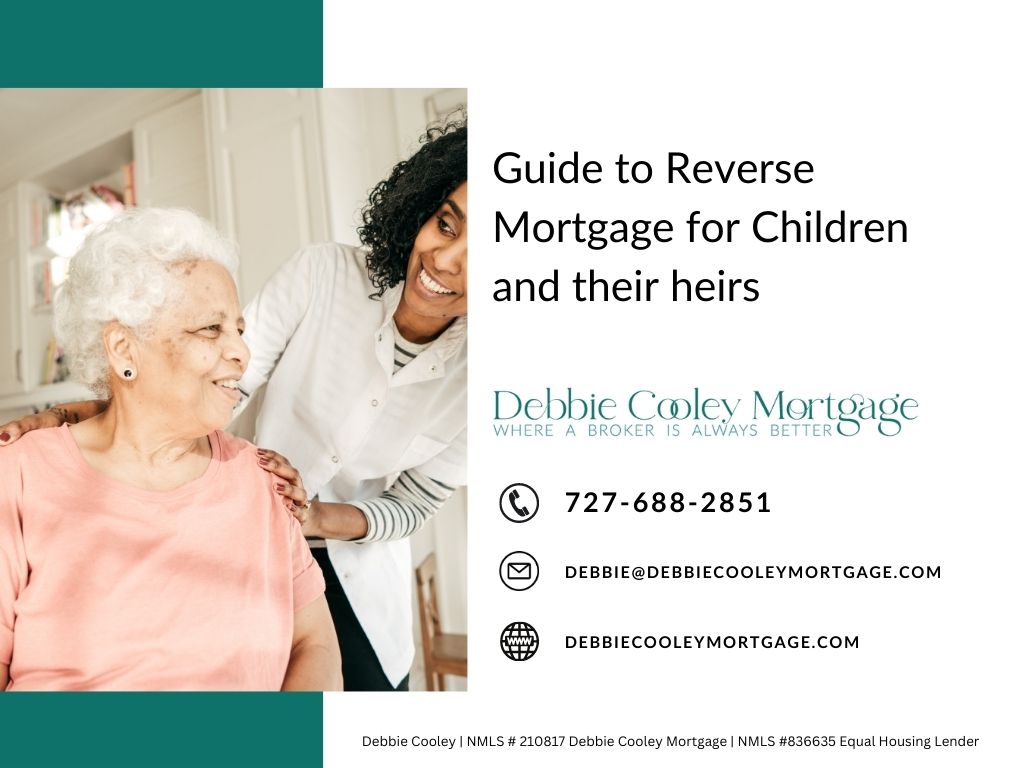Guide to Reverse Mortgage for Children and their heirs
When heirs learn about a reverse mortgage after losing a loved one, they may not appreciate the many benefits their parents received. In addition, they may have some confusion about their responsibilities and what will happen with the loan next. This guide is to help children and heirs navigate a reverse mortgage once their loved one has passed away. Here, we address the processes surrounding a home equity conversion mortgage (HECM) or federally guaranteed mortgage.
Why Did Your Parents Take a Reverse Mortgage?
Ideally, when parents take out a reverse mortgage, they share that information with their children and heirs. Those talks might focus on the purpose of a reverse mortgage, the terms of the loan, and what heirs and children need to do should they want to keep the house after the last surviving borrower passes away.
Often, however, parents don’t discuss their financial decisions with their children. Hopefully, the borrower left loan details with all other important financial documents for their heirs in these cases. But even if they receive proper documentation, heirs who were unaware that their parents had taken a reverse mortgage may feel disappointed and confused.
If your parent took a reverse mortgage without informing you, it can be helpful to understand that people take reverse mortgages for a variety of reasons, including achieving financial flexibility that otherwise might not have been possible.
With a reverse mortgage, the equity they have built up in their home over many years can offer a needed source of income or an avenue to continue living in a home they love. In some instances, a reverse mortgage allows people to remain financially independent in their later years.
Though it can seem selfish, parents often take a reverse mortgage to avoid placing a financial burden on their adult children. Everyone’s situation and motivations are different, but looking at the terms of the reverse mortgage can help you contextualize the benefits your parent and even you received in the transaction. It can be painful to realize you will not receive something you believed you would, but perhaps even more painful is imagining what your parents’ and your life might have been like if it had not been available.
What Happens After the Last Borrower’s Death
Once the last borrower on a reverse mortgage dies, the loan becomes due and payable. This sounds very harsh and final, but it does not mean heirs are required to come up with the money immediately or at all. It does, however, set in motion a chain of actions that will lead to the termination of the loan.
Heirs have up to 12 months to repay the loan balance from the date of the borrower’s death. In certain cases, an extension may be granted. Still, it is usually in your best interest to pay the loan back as soon as possible because interest continues to accrue on the balance until the loan has been paid. Any additional equity still in the home will be diminished the longer the heirs avoid taking action.
One of the first actions to take when heirs learn about a reverse mortgage is to contact the loan servicer to inform them of the last borrower’s passing. The heirs should give the loan servicer the will and any court documents giving them authority to deal with the home. After providing this documentation, heirs can also request an estimated payoff to determine the amount of equity remaining in the home.
A Reverse Mortgage Timeline
The following timeline is what heirs can expect after a reverse mortgage comes due.
-
30 days. The lender will send a due and payable notice to the estate within 30 days of receiving a notice of death. This notice will contain information on how heirs can proceed and the eligibility requirements of any extension periods. The wording of this letter may seem harsh, but lenders are required to follow specific FHA guidelines and verbiage.
-
60 days. Heirs must obtain an appraisal of the home no later than 30 days after the due and payable notice is sent. An appraisal is not required if the home is sold and the loan is paid in full. There is also flexibility on this timeline if heirs provide evidence that the home is listed to be sold.
-
2 – 6 months. A decision needs to be made about selling the home, or how the heirs will satisfy the loan requirements.
-
6 months. Lenders may start foreclosure on the home if no actions have been taken to repay the loan. Again, this is in the case that heirs have not contacted the servicer, or otherwise made their intentions for the loan clear.
Regardless of where they are in the decision-making process, it is a good idea to maintain constant communication with the servicer. If children or heirs are not making any attempt to sell the property or repay the loan and haven’t requested an extension, FHA guidelines require the servicer to foreclose on the home.
Debbie Cooley-Guy is an excellent resource for any of your mortgage needs from the first-time home buyer to the last mortgage of a lifetime. Call Debbie @ 727-688-2851
for a free consultation.
Debbie Cooley Guy, Loan Originator NMLS #210817
Equal Housing Lender
#reversemortgage #seniorliving #Financialfreedom #aginginplace #equityrelease #independentliving
